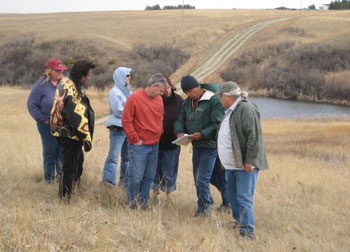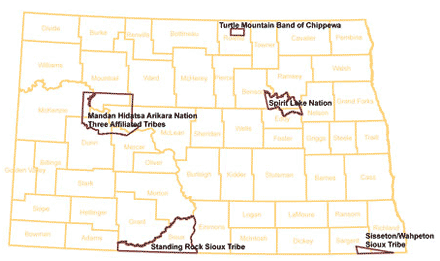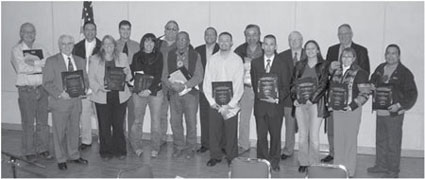NORTH DAKOTA DEPARTMENT OF TRANSPORTATION
Tribal Consultation Programmatic Agreement
Program Description

North Dakota DOT Tribal Transportation Committee meeting in the field.
(Source: Federal Highway Administration.)
Program Benefits
- The State’s programmatic agreement (PA) provides a single set of procedures for Tribal consultation. The PA also creates a process for discussing and resolving problems. From the Tribes’ perspective, their views are now being heard and respected by the agencies.
- The PA fosters inter-Tribal relationships regarding historic preservation issues affecting properties on the Northern Plains, and allows North Dakota DOT to address these properties as a group, as opposed to on a site-by-site basis.
- The PA avoids areas of conflict which can delay subsequent projects, resulting in more realistic project schedules and budgets.
Initially, the Federal Highway Administration (FHWA) and the North Dakota Department of Transportation (NDDOT) consulted with Federally recognized Tribes with historic ties to territory within the State on a project-by-project basis. The goal of this consultation was to balance transportation needs with Tribal concerns about places of religious and cultural significance. Through these consultation efforts, the agencies established working relationships with individual Tribes based on mutual respect. In 2004, NDDOT met with the Tribes to discuss ways of improving the Department’s Tribal consultation efforts. NDDOT asked the Tribes if they would be interested in entering into a Programmatic Agreement (PA) and was prepared to write agreement documents for each Tribe. The Tribes, however, said they wanted a single consensus document that was negotiated concurrently with all parties. Multiple meetings were held between NDDOT and the Tribes to draft the PA, during which NDDOT continued to consult with the Tribes on a project-by-project basis. The PA took two years to develop and was signed in 2006. The idea of developing a consensus PA received a high level of support from upper management within NDDOT, which was open to the idea of maintaining positive relationships with the Tribes.
Setting Up the Program
Program Elements
- Historic Preservation
in Transportation Planning
- Historic Preservation in Early
Project Development
- Programmatic Approaches
to Identifying, Evaluating,
and Managing Historic Properties
- Process for Tribal Consultation
One staff member within NDDOT was designated the point person for developing the PA. State funds were used to prepare the PA, which included hiring a consultant to assist in drafting the PA, and to manage the Tribal representatives’ travel costs to attend meetings to work on the PA. NDDOT’s point person currently serves as the Department’s Tribal Liaison/Consultation Specialist.
Under the PA, NDDOT has authority to speak with the Tribes on behalf of the FHWA, although the FHWA retains government-to-government consultation responsibilities. The DOT handles all day-to-day consultation.
Challenges Encountered
The duties of the Tribal Liaison were assigned to the NDDOT staff member who already was engaged in Tribal consultation, so funding the position was not an issue. Additional funding was needed, however, to pay for the annual Tribal meetings hosted by NDDOT. There were some problems initially with paying for food and securing rental space needed for the meetings at State rates, but upper management supported these expenditures.
Program Maintenance

North Dakota Tribes.
(Source: North Dakota State Historic Preservation Office.)
NDDOT’s Cultural Resource Section continues to work with regional Tribes (currently 14 Tribes and bands) under the 2006 PA. As part of the agreement, NDDOT hosts two meetings a year where all parties meet to discuss the State Transportation Improvement Plan (STIP), upcoming NDDOT projects, previous projects, and related issues.
The program is relatively inexpensive when compared with the overall level of Federal funding coming into the State. NDDOT spends approximately $100,000 a year to host Tribal meetings and typically another $50,000 on specific project Tribal involvement efforts.
The Tribes continue to enthusiastically participate in NDDOT’s Tribal meetings, which continue to grow both in size and spirit.
There has been no change in the State funding for the Tribal Involvement Program nor have there been any difficulties in maintaining the program. The program has the commitment of upper management, which sees the benefits of fostering a good relationship with Tribes and assisting FHWA in their compliance needs.
The NDDOT Tribal consultation PA continues to have great support from FHWA, NDDOT, and the Tribes.
Critical Factors for a Successful Program

North Dakota Tribal Consultation PA Plaque Honorees, November 2006.
(Source: “In their Own Light: A Case Study of Effective Tribal Consultation,” U.S. DOT, FHWA.)
A critical factor in the success of the Tribal Involvement Program is the support of NDDOT management. NDDOT management had to have the will, the vision, and the spirit of true partnership needed to see the world through someone else’s perspective.
The foundation of this program was forged by FHWA, NDDOT, and the Tribes working together to create a process that would work for all the parties, which was then codified into the PA. The PA was created by sitting at the table together and discussing the issues.
June 1, 2012

